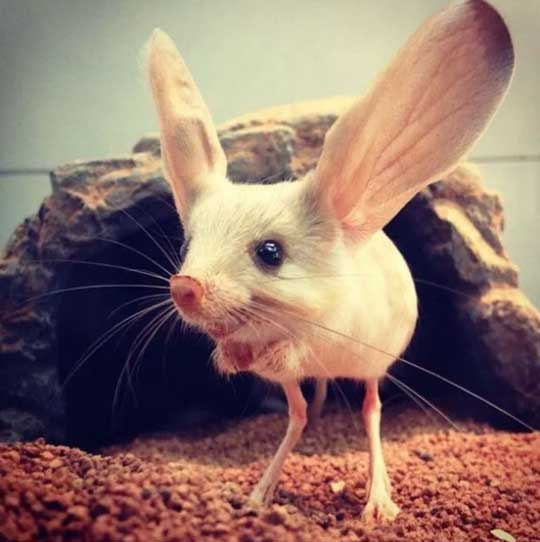Your Right To Info
AK Singh
The jerboa is a small, hopping rodent that lives in the deserts of Northern Africa and Asia. Jerboas are very cute and have exceptionally long ears, tails, and hind feet that cause them to look like a caricature instead of a real animal. They can also leap several feet in a jump because of their specially adapted legs. Although jerboas drink water in captivity, in natural habitats they obtain it from food, which is mostly plants and insects.
A Jerboa can easily pass off as a mini kangaroo. It has long hind legs and shorter front ones. It has a small frame of 1.7 inch and is also known as Dwarf Three-Toed Jerboa. Jerboa's movement is usually by leaping horizontally, vertically and. This cute clan has 33 species in total. Despite their adorable appearance, it is illegal to have a jerboa as a pet. Since they do not thrive in captivity, it is also cruel to the animal. They can survive temperature fluctuations from below freezing to more than 130 degrees Fahrenheit. A jerboa’s tail can be twice as long as its body, which is usually about two to six inches long. These rodents live in burrows, especially to escape heat and predators.
Amazing facts about Jerboas
Jerboas are fast, and they get around by jumping (like kangaroos). To help them do this, they have hind legs that are at least four times longer than their font legs. But they have a strange habit of zigzagging back and forth as they run (or hop). One possible reason for this is that it helps them avoid predators, such as snakes and owls. Also, this pattern may help them find food sources, which, in a desert, tend to be spread out and random. There must be a darn good reason they zigzag like this, because studies show that this is not as energy-efficient as hopping in a straight line. Even so, jerboas can run (hop) up to 16 miles per hour (25 km/hr).
Jerboas don't drink water. Ever. Instead, they get all the water they need from the food they eat. Their diet consists mainly of plants, although unlike many other rodents, they are incapable of eating hard seeds. They also will happily eat any insects they can catch.
Six of the 33 species of jerboas are pigmy species. And some of these pygmy species could, quite honestly, be the cutest rodents ever. The long-eared jerboa has ears that are two-thirds as long as its body. This is the largest ear-to-body ratio of any animal in the world! Here is an interesting way to describe this (from a National Geographic article): "If basketball superstar Yao Ming was a long-eared jerboa, his ears would be the same size as Jada Pinkett Smith. He’s 7.6 feet (2.3 meters) tall, and she’s 5 feet (1.5 meters)." So what's up with these long ears? Actually, many mammals that live in hot deserts have longer ears than their counterparts living in cooler areas. The long ears help to cool the animal's body. As blood flows through the vessels in the ears, the blood is cooled down. This cooler blood then returns to the main body and helps cool the entire animal.
Jerboas can really jump. Some of the species can jump vertically six feet (1.8 m) high. Let's put this into perspective. The average jerboa stands about four (10 cm) inches tall. So, the creature can jump straight up 18 times its own height. I'm 5 feet 10 inches tall (178 cm). If I were a jerboa, I would be able to jump 35 yards (32 meters) straight up. This sounds like it would be fun, but when I fall 35 yards back down, the fall would probably kill me.
Jerboas use their long tails to help balance them as they hop. But they also use the tail to prop themselves up when they stand upright (remember, their front legs are really short, kind of like T-Rex arms-not much good for standing on).
Jerboas spend most of the daylight hours in their burrows beneath the ground. Jerboas build both temporary and permanent burrows. Permanent burrows are sealed and camouflaged with many entrances. They have a nesting room and food storage rooms. They come out to forage for food at night, which is why they have such large eyes.
Female jerboas usually give birth to between two to six babies in a litter twice a year.
Baby Jerboas develop slowly compared to other rodents. When they are born, their hindlegs and forelegs are the same length. The hindlegs do not develop until they are 8 weeks old, and they cannot jump until they are 11 weeks old! They may be slow to develop, but they live longer than other rodents. Jerboas live about six years in the wild, which is twice the average lifespan of rats.
One more tidbit of information: During World War II, Britain chose the jerboa as the mascot for the country’s 7th Armoured Brigade. They named the brigade the Desert Rats. The brigade fought in World War II campaigns in North Africa. Why did they choose the jerboa? according to the story, Major General Michael O’Moore-Creagh wanted his troops to share the animal’s tactic of popping up, having a quick look around, and popping back down.
















Leave a comment